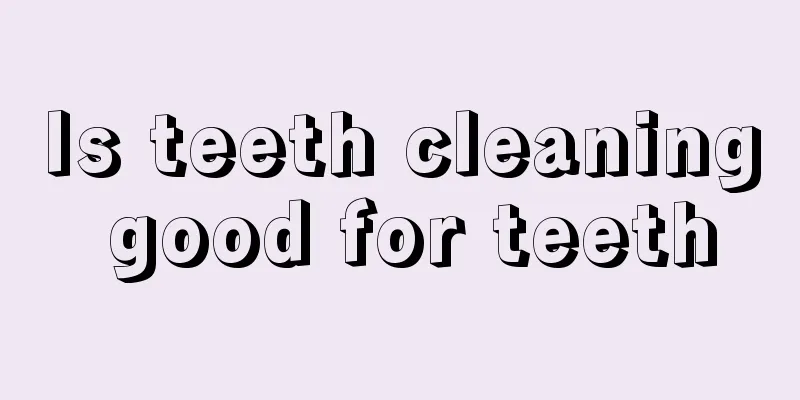Is teeth cleaning good for teeth

|
In our daily life, we often see many people with a lot of stains on their teeth. These people need teeth cleaning to whiten their teeth, but many people wonder whether teeth cleaning has any effect on the health of their teeth. Any tooth whitening procedure will definitely have a certain impact on the body, and teeth cleaning has its own advantages and disadvantages. Manual teeth cleaning is time-consuming, labor-intensive and inefficient. There is also an ultrasonic teeth cleaning method. This type of teeth cleaning method will not make us feel uncomfortable during the process, so it is a good choice for people who want to clean their teeth. People should not make teeth cleaning a habit, as it will have a certain impact on our gums. Teeth cleaning methods and advantages and disadvantages: Teeth cleaning can be divided into manual cleaning and ultrasonic cleaning according to the different instruments used. Manual cleaning is performed using different types of manual scalers, while ultrasonic cleaning is performed using an ultrasonic scaler. 1. Manual cleaning The disadvantages of manual cleaning are obvious, namely, it is time-consuming and labor-intensive. It usually takes about 3 hours to complete manual cleaning of the entire mouth of teeth. For patients with a lot of tartar, it may even have to be done in several sessions. The patient needs to keep his mouth open during this process. Keeping the mouth open for a long time is undoubtedly very uncomfortable for the patient, and the long operation is even more of a torture for the doctor. Therefore, manual cleaning is used less and less in clinical practice, and is replaced by ultrasonic cleaning. However, manual cleaning also has its advantages. For doctors, manual cleaning feels better and they can feel the presence of tartar more clearly. The force of manual cleaning is relatively gentle, and there is no water spray during the operation, so the patient will not feel strong discomfort, and the chance of cross-infection in the clinic will be reduced. 2. Ultrasonic cleaning The ultrasonic dental cleaner consists of an ultrasonic generator and a transducer. The generator emits electromagnetic oscillations and amplifies the power. The transducer converts high-frequency electrical energy into ultrasonic vibrations with a vibration frequency of 20,000 to 45,000 Hz. The high-frequency oscillation of the working head on the transducer removes tartar attached to the tooth surface. The working head of the ultrasonic dental scaler has various shapes, such as pointed round and flat, etc. You can choose the appropriate working head according to the size and location of the tartar. In addition, the ultrasonic dental cleaning machine is also equipped with a water spray system. When the ultrasonic vibration of the working head is started, the water spray system sprays water to the working head at the same time to form an aerosol. On the one hand, it plays a role in cooling the working head. Another important aspect is to form a cavitation effect, that is, there are tiny vacuum bubbles in the spray water droplets that collapse rapidly to generate energy, which has a flushing effect on tartar, plaque, etc., and washes away the broken tartar and blood stains. The advantage of ultrasonic cleaning is that it saves time and effort. Generally, the supragingival cleaning of the entire mouth of teeth can be completed in about an hour. After ultrasonic cleaning, a probe should be used to carefully check for any missed tartar. If some small tartar and tartar on the adjacent surfaces are left, they should be cleaned away with manual instruments. In addition, some patients are not suitable for ultrasonic cleaning. Patients with infectious diseases such as tuberculosis, hepatitis B antigen positive, HIV infection, etc. are prohibited from using ultrasonic dental scalers because the spray it produces will contaminate the operating area and the surrounding environment. Patients with respiratory diseases should not use ultrasonic dental scalers, such as patients with respiratory depression, patients with chronic lung disease, etc. The water spray and mist during ultrasonic treatment may bring danger to these patients. Generally, patients with pacemakers are prohibited from using ultrasonic dental scalers to avoid symptoms such as heart rhythm disorders caused by interference with the pacemaker. As for the pros and cons of teeth cleaning, the appearance of teeth can definitely satisfy our desires, but teeth cleaning will cause certain damage to the health of our gums, so we should be cautious about teeth cleaning in daily life. It is best to consult a doctor's advice and suggestions in time when choosing teeth cleaning. |
>>: The harm of automobile exhaust to human body
Recommend
Can patting your stomach after a meal help you lose weight?
Belly fat has always been a problem that has trou...
How to treat midge bites
In some weedy areas, pests such as midges are pro...
How much does chemotherapy for endometrial cancer resection cost
Endometrial cancer is a common tumor. The uterus ...
Can I take anti-inflammatory drugs while getting eyebrow tattooed
Every part of the five facial features is very im...
What is the treatment plan for osteosarcoma
The treatment of osteosarcoma is a comprehensive ...
Will red-skinned peanuts fade when soaked in water?
It is true that red-skinned peanuts did not fade ...
How to treat pituitary tumors
People are no longer unfamiliar with the disease ...
What to do if patients with advanced liver cancer experience pain
Pain in the liver area is a symptom that runs thr...
Tips for repairing thin stratum corneum
People with too thin stratum corneum tend to have...
What should I do if flesh grows inside a decayed tooth
The treatment of tooth decay should be carried ou...
What are the health care common senses for brain cancer
Brain tumors are primary tumors that grow inside ...
How to get rid of dandruff, teach you simple and practical methods
Many people have dandruff problems. How to get ri...
How are birthmarks formed and what are the aspects
Birthmarks are a common skin condition that occur...
What is moderate fatty liver?
Patients with moderate fatty liver will have some...
Characteristics of bronchiectasis cough
Most cases of bronchiectasis are caused by infect...









